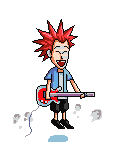Welcome!

This is my first post so bear with me... i have so many things in mind but i don't know where to start. My head suddenly aches, so I look for articles such as this one below that will help cure some headache. This news was originally from New York Times dated Novenber 7, 2006.

It May Come as a Shock
Scribonius Largus, physician to Emperor Claudius, was a staunch advocate of the remedy. “To immediately remove and permanently cure a headache, however long-lasting and intolerable, a live black torpedo is put on the place which is in pain, until the pain ceases and the part grows numb,” he wrote in the first century.
Electric fish have long disappeared from the medical armamentarium. And patients with headaches are most frequently treated with pharmaceuticals.

But recently, electrical or electromagnetic devices that hark back to the head-zapping torpedo fish have come into vogue among the country’s most prominent migraine researchers. Two different kinds of stimulatory devices are now in large-scale clinical trials for possible use in patients with the most severe migraine cases. Many researchers believe that such devices are likely to play a greater role in migraine treatment in the future.
Roughly 30 million Americans suffer from migraines, an inherited neurological disorder characterized in part by painful, throbbing headaches.
Dr. Richard B. Lipton, a professor of neurology at the Albert Einstein College of Medicine and director of the Montefiore Headache Center, says that while there are many drugs to treat the disorder or ward off the pain of an attack, some people do not respond or cannot tolerate the side effects.
“There is still a lot of unmet need,” Dr. Lipton said. “So the idea of having stimulatory devices that can be used to prevent headaches or to treat them acutely is very attractive to me, and I think very attractive to patients as well.”
The two kinds of stimulatory approaches now in large-scale clinical trials are occipital nerve stimulation, or O.N.S., and transcranial magnetic stimulation, or T.M.S.
In occipital nerve stimulation, a pacemakerlike device is connected to electrodes placed at the back of the head just under the skin. Electrical current is delivered through these electrodes, with the goal of inhibiting or preventing migraine pain.
In transcranial magnetic stimulation, a magnetic device is pressed to the back of the head, and brief pulses are delivered, altering electrical activity inside the brain in hopes of halting the migraine before it progresses. This approach is being studied only for patients whose migraines begin with an aura, or premonitory phase, that is typically characterized by flashing lights or other visual disturbances.
Experts say approaches like these represent a powerful new trend in migraine research.
“Since 1990, there have been well over 100 clinical trials for migraine drugs,” said Dr. Lipton, who added that by comparison virtually every stimulatory-device study that has been started is still going.
Some patients who have undergone the treatments say that they have helped.
Cheryl Myers, a mother of two who lives near Columbus, Ohio, said that for 9 or 10 years she suffered from chronic and disabling migraines that forced her to stop working and often confined her to bed.
“The only thing that helped was narcotics,” said Ms. Myers, 49. “But I couldn’t be taking them three or four times a week.”
In 2004, Ms. Myers enrolled in a clinical trial at the Michigan Head-Pain and Neurological Institute, where she had an occipital nerve stimulator surgically implanted.
The pacemakerlike device was placed in her upper buttocks and connected, by way of wires tunneled under the skin, to electrodes at the base of her neck, on either side.
Soon after the device was turned on, Ms. Myers said, she began having fewer migraines, and those she did have were less severe. Within a few months, she was also able to return to work several days a week. “I am not headache-free,” she said, adding that she still has “one or two headaches a week” and takes Percocet, a pain-relieving narcotic.
“However, I am enjoying a much more normal life,” she said.
Dr. Joel R. Saper, director of the neurological institute, said that in the treatment, electrodes are positioned to stimulate the greater occipital nerve, which runs along the back of the head on either side. The occipital nerve converges in the upper or cervical spinal cord with the trigeminal system, which includes neurons and neural pathways responsible for conveying much of the throbbing pain associated with migraine, he said.
Dr. Saper says it is not clear precisely how occipital nerve stimulation works. But one possibility is that it effectively inhibits activity in the trigeminal system, dampening the patient’s pain.
Three companies are conducting large-scale clinical trials of three different occipital nerve stimulators for use in migraine patients. The companies are Advanced Neuromodulation Systems, a division of St. Jude Medical; Advanced Bionics, a Boston Scientific company; and Medtronic.
Though the studies are not done, Dr. Saper, who has served as an advisory board member for all three companies, said that outside of the trials, “it is clear that some people get better but some people don’t.”
Dr. Saper said the treatment was appropriate only for patients who did not respond to less invasive approaches.
In 2003, Kerrie Smyres of Seattle was implanted with an occipital nerve stimulator that was not part of a clinical trial. In 2005 the leads from the electrodes began slipping out of position. When the leads moved, they caused a sharp pinching pain and sometimes set off another migraine.
The device meant that some kinds of activity that had helped her maintain a positive state of mind were off limits, including yoga and kayaking.
“Over time, I realized that it caused more pain and was more limiting than it was helping,” she said of the device.
So in September, Ms. Smyres had her stimulator removed.
“More than anything, I worry about patients who act on desperation like I did and then have their hearts broken, like I did,” said Ms. Smyres, who in 2005 began a blog about migraines called The Daily Headache.
Transcranial magnetic stimulation, the other type of stimulation being tested for migraines in large trials, does not require a surgical procedure. Rather, it uses magnetic pulses, delivered through the skin, to induce electrical changes in a particular brain area.
Dr. Yousef M. Mohammad, a neurologist at Ohio State University Medical Center, said preliminary research, conducted by his group and others, indicated that this approach might prove helpful to migraine patients who experience an aura before developing a pounding headache.
In a study of 43 patients conducted by Dr. Mohammad and his colleagues in 2004 and 2005, participants came to the medical center’s emergency room when they began to experience an aura, and were then given either transcranial magnetic stimulation or a sham treatment.
Two hours after being treated, 74 percent of the patients who received magnetic stimulation said they had no headache or a mild headache, compared with 45 percent of the patients in the control group.
Dr. Mohammad presented the results at the annual conference of the American Headache Society in June.
Christina Sidebottom, a retired technical writer who participated in the study, said that after stimulation, she would still get a mild headache, but never the intense throbbing pain she had before. “It was like having discovered Aladdin’s cave,” she said.
Initially, the study participants were required to come to the emergency room for treatment because the magnetic stimulation devices were cumbersome (weighing roughly 80 pounds, they are modified versions of machines used for brain mapping).
The California-based company Neuralieve has since developed smaller, portable devices that resemble ray guns and weigh just under three pounds. It is these devices that are being tested in the current trial, which involves several medical centers (Dr. Lipton heads the Neuralieve medical advisory board).
Gary H. Stroy, president and chief executive of Neuralieve, said that depending on the result of the trials and whether the Food and Drug Administration approves the device, a portable stimulator could be on the market in about 18 months. The stimulator is available now only to migraine patients participating in the research study.
Dr. Mohammad, who is on Neuralieve’s medical advisory board, said the idea of using electrical or electromagnetic stimulation to treat migraines resulted partly from a shift in how neurologists understood the disorder. Modern medicine has viewed migraines primarily as a vascular problem. Blood vessels in the brain constricted, then subsequently dilated, irritating the nerve endings around them and causing pulsating pain.
More recently, however, scientists have come to view these vascular changes as secondary to underlying neural events. For some patients who experience an aura, a wave of electrical excitation appears to spread through an area of the brain called the occipital cortex. Because this area governs vision, patients may see flashing lights, dancing bright spots or wavy lines, or they may experience a blind spot in their vision. If the excitation spreads to other areas, other neurological symptoms — like numbness, tingling or difficulty speaking — may occur.
Intense excitation is soon followed by exhaustion or depression of the affected brain cells, Dr. Mohammad said. The end result of this process, known technically as “cortical-spreading depression,” is irritation of trigeminal nerve fibers — and a throbbing, pounding headache.
The goal of transcranial magnetic stimulation is to interfere with the initial wave of excitation, thereby preventing the migraine from proceeding to the headache phase.
Dr. Mohammad offered an analogy of a forest fire. “If you cut some trees in the middle then the fire will not spread,” he said. “That is what we’re doing with T.M.S.”
The treatment is noninvasive and does not appear to have side effects, he added. So for some patients, it might be a first or second approach, rather than a treatment of last resort. “We are treating electricity with electricity rather than treating electricity with chemicals,” Dr. Mohammad said.
Roughly 20 percent of migraine patients experience an aura, according to the National Headache Foundation. But for those who do not, it is not clear whether cortical-spreading depression occurs in some other area of the brain or whether an entirely different mechanism is at play. It is also unclear whether transcranial magnetic stimulation would be useful in these cases.
Dr. David W. Dodick, a professor of neurology at the Mayo Clinic Arizona, said that while the biology and treatment of migraine have come a long way in the last 20 years, scientists needed to develop a better understanding of the mechanisms that initiate an attack, as well as the mechanisms by which some patients develop frequent and sometimes daily headaches.
Genetics are thought to play a major role in predisposing people to migraines. And in those who are predisposed, migraine attacks can occur spontaneously or be set off by a host of environmental factors, including stress, noise, bright lights, changes in sleep patterns and certain foods, as well as fluctuating estrogen levels, which may be why the disorder is about three times more common in women than in men.
But how these factors interact and the specific ways in which they exert an influence on neural processes are not well understood, said Dr. Dodick, who is involved in experimental work on occipital nerve stimulation and has served as a science adviser to Neuralieve.
Neurologists also do not know where in the brain a migraine begins and how additional areas are involved as the attack progresses, the details of which may be different for different patients.
Cortical-spreading depression may occur in some people, Dr. Dodick said. But other neural mechanisms are almost certainly at play, as well, and may turn out to be even more fundamental. Dysfunctional pain control centers in the brain stem may prove to be a root cause of the disorder, at least for some.
Nonetheless, he said, once the basic science of migraine is better understood, it will be possible to develop pharmaceuticals that aim to prevent attacks without untoward side effects. “That’s where I believe the future is.”
J. Steven Poceta, a neurologist at the Scripps Clinic in La Jolla, Calif., who is not involved in the current trials, also focused on the importance of new drug discoveries. Dr. Poceta emphasized that migraines are a progressive disorder, with headaches often becoming more frequent and less amenable to treatment. The goal, he said, is to develop drugs that can stop the progression before it gets to the point where nothing works.
“The brain is an organ that learns,” he said. “That’s its basic job. So the more it does something, the more it tends to do that same thing.”

 Me... I'm just a normal individual with a little sense of humor, with a keen observation anything under the sun. Quiet(but not most of the time). Welcomes new friend who can share same interest.
Me... I'm just a normal individual with a little sense of humor, with a keen observation anything under the sun. Quiet(but not most of the time). Welcomes new friend who can share same interest. Good News
Good News 














